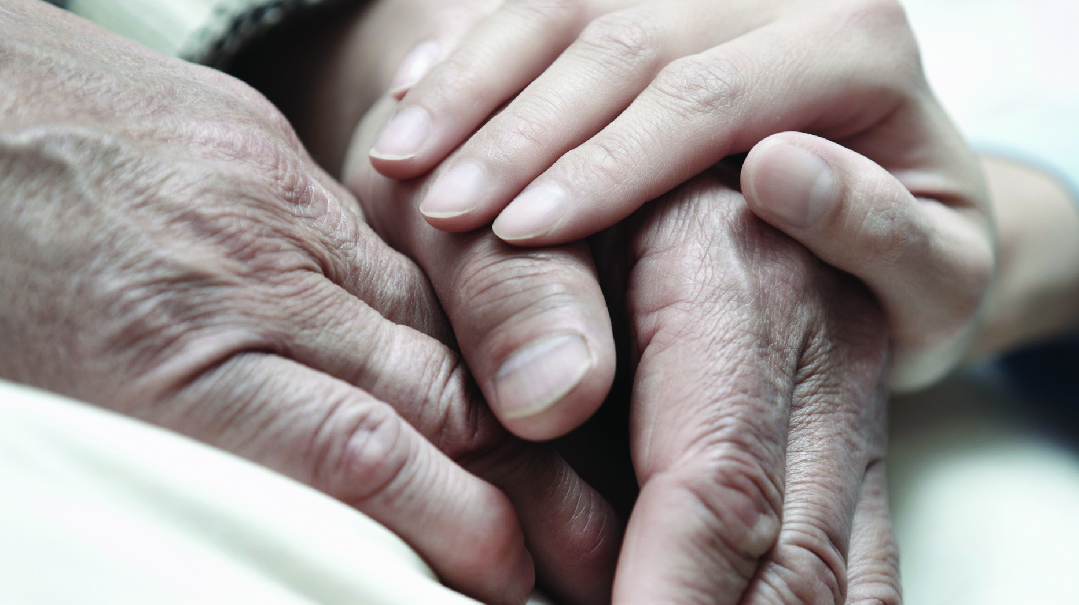Life After Paralysis


I ’m standing in a New York City subway station waiting for the train. Suddenly the walls of the station start to close in on me.
Like a giant boa constrictor the walls wrap themselves around my body squeezing the breath out of me. My heart catapults against my throat. Wham wham wham. The people standing on the platform start to swim before my eyes. The boa constrictor tightens its grip. I can’t breathe! In another moment I’ll faint. Help! Get me out of here!
I bolt from the subway platform fly through a turnstile and gallop up a flight of steps. Fresh air! I am free!
I remember my first-ever panic attack as if it happened yesterday. In truth it happened 38 years ago when I was 20 and expecting my eldest daughter. It was the last time in two decades that I would set foot into a subway station.
From then on I took the bus every day to Touro College even though it added a considerable amount of time to the trip. I didn’t tell anyone not even my husband or my friends at school why I had stopped taking the subway. “It works better for me ” was the only explanation I gave. How could I tell anyone that I was afraid the subway station would squeeze me to death?
About a month after the subway incident the thought of being on a bus started to frighten me as well. I couldn’t avoid taking buses but each time I got on a bus I couldn’t wait to get off.
After that I added a new fear practically every day. What if I step into that elevator and it gets stuck? What if I’m in the car and there’s a traffic jam and I need to get out? What if I collapse in the simchah hall during a wedding?
The fear itself created its own fears. What if I’m grocery shopping and I have a panic attack in middle of the vegetable aisle in front of everyone? I was so afraid of panicking that I started to avoid going out. I ordered groceries by phone so I wouldn’t have to risk anxiety attacks in the supermarket. I stopped going to weddings and other social events with the excuse that I wasn’t feeling well. Each time we received an invitation I became a nervous wreck. How could I possibly attend my neighbor’s son’s bar mitzvah? I’d have to go to shul!
I managed to cover up my anxiety and keep it a secret from everyone including my husband Shaul. When I was afraid to go somewhere I said I had a headache or a stomachache or some other health problem. I was deeply embarrassed about my fears knowing that they made no sense. But the knowledge that my fears were irrational did nothing to mitigate them.
I graduated college with a degree in early childhood education and began working as a preschool teacher. One morning about a year after my first panic attack in the subway station the thought of leaving the house made me feel violently ill and nauseated. I was sweating buckets my heart was pounding and I could hardly breathe. So I called my principal and told her I wasn’t feeling well.
This is crazy I thought. I just called in sick even though there’s nothing wrong with me.
Realizing that I had to do something about this, I decided to tell Shaul about my paralyzing fears.
“Ah,” he said. “So that explains it. You haven’t been yourself for a long time, but I couldn’t put my finger on what was wrong.”
Shaul booked an appointment for me with a psychiatrist and accompanied me to the appointment. The psychiatrist prescribed an anxiety medication called Ativan to be taken as needed, which was pretty much 24/7. I also went to see several psychologists, but none of them had much to offer me. This was 30 years ago, when no one talked about anxiety, and the standard treatment available was medication. Psychologists had no relief to offer; the only thing they could do was pinpoint certain instances in my childhood that likely contributed to my current anxiety, but all that accomplished was to make me angry at my parents.
The medication made me feel drugged and spacey, but did not stop me from being tense and afraid. All it did was take the edge off the panic, which was enough to get me to drag myself to work every day. Once I was in my preschool classroom and busy with my young students, my mind stopped tormenting me. My teaching assistants never noticed anything, because I was a master at covering up the symptoms of my anxiety when it started to gnaw at me. As soon as it was time to leave, the feelings of terror hit me again, lasting until I reached the safety of home.
One day, I came home feeling so anxious that I thought I would either faint or have a heart attack. I called the office of the psychiatrist and asked if I could come in for an appointment, but it was the day before a legal holiday, and the secretary informed me that the doctor would not be in for another two days.
“I don’t know if I’m going to be around in another two days,” I cried to the secretary. “I can’t live like this anymore.”
“You’d better get yourself to a hospital, and fast,” she said in alarm. I felt so awful that I obeyed. Shaul drove me to the hospital, where they gave me some medication and sent me home, after determining that I was not a suicide risk.
I was a young mother of three adorable children, I had a wonderful marriage, and I had no serious health or financial problems. To the world, it looked like I had it all — and I played the part to perfection, looking vibrant and happy on the outside. Inside, however, I was a disaster. I worried about everything, and my fear and anxiety made me so miserable that I found myself wishing at times that I wouldn’t wake up in the morning. I knew I had so much to be thankful for, but I felt that my life was torture.
I would take the kids to the doctor when I had to, but sitting through the appointments was agonizing. School events were a nightmare. Once, in the middle of my daughter’s Bais Yaakov play, I felt the walls closing in on me. I looked around and saw happy moms and grandmothers smiling and clapping, yet I had no idea what the play was even about. I was plotting how to escape, and envying the normalcy of the other mothers. When I could bear it no longer, I hurried out of the school, feigning illness as always. I told my daughter to find a ride home.
I had always been an outgoing person who loved getting out and going places, but as the years went by, I turned into a virtual hermit. Other than going to work, which I did by convincing myself that once I got there I’d feel better, I hardly went out alone. Most of the time, I would only agree to leave the house if Shaul accompanied me. He was a source of safety, and being with him was next best to being home.
Family outings meant just Abba and the kids, because, as usual, Mommy “wasn’t feeling well.” If we’d go out to a restaurant, I’d check my watch nonstop, just waiting for the moment when we could go home.
At home, I was perfectly fine. Home was my “safe place,” where I could really enjoy the kids, playing and singing with them and helping them with their homework. We used to host guests for Shabbos, but that stopped when they reciprocated by inviting us back and I always had a reason to decline.
When Riva, my oldest, was eight years old, Shaul finished medical school and was scheduled to take his final medical school exams in a different city, which happened to be where his sister and her family lived. It was an exciting time for us, and we decided to make it a family trip. But I pulled out at the last minute because of all the dreadful scenarios whizzing around in my brain. What if I feel sick in the car? What if we get stuck in traffic? What if something happens to the kids while we’re away? What if we get into an accident? So as we were getting ready to leave, I said I didn’t feel well, which meant that Shaul had to drive the kids five hours on his own and leave them with his sister while he took his exams. Instead of this being a nice family trip, it turned into a nightmare for everyone.
Over the years, my anxiety got worse and worse. Somehow, I dragged myself through each day, avoiding whichever out-of-the-house obligations I could and suffering through whichever ones I couldn’t.
When Riva went off to seminary in Israel, I missed her terribly and wanted to visit her, but the thought of getting on a plane to Israel sent me into a panic. Of all the terrifying scenarios I could imagine, being on a plane for 12 hours topped the list. I wasn’t afraid that the plane would crash or be hijacked; I was afraid that I would need to get off the plane and wouldn’t be able to.
That year, a cousin of mine got married in England, and we decided to fly to England for the wedding and have Riva fly there to meet us. Even a seven-hour plane ride was so scary that I had to take Ativan throughout the trip. I spent a week in England in a drugged-up haze, consumed with worry about having to get back onto the plane.
After our trip, Shaul came across an ad for a program to help people with agoraphobia, which is defined as “extreme or irrational fear of crowded spaces or enclosed public places.” This description, he realized, fit me to a T. Being a doctor, he was skeptical about non-medical interventions, but at this point, he was desperate to help me. All the years, he had been supportive and understanding, but living with an anxiety-ridden wife was no small challenge.
The program being advertised involved a series of recordings that featured people talking about how they had learned to overcome their anxiety, followed by an instructor speaking about tools for combating fear in general, and specifically agoraphobia.
One tool was a simple breathing exercise that involved taking a deep breath, pushing your stomach out as the air filled you up, holding the breath in for ten seconds, and then blowing it out slowly. After doing that three or four times in a row — which only took about a minute — I could actually feel my pulse slowing down and my body starting to relax.
“When you feel anxious,” the instructor explained, “you start to hyperventilate, which reduces the oxygen supply to the body and makes you feel as if you can’t breathe and you’re going to faint. But the truth is that you won’t faint from anxiety, because your brain will kick in and make sure that doesn’t happen. You only feel as if you’re going to faint, which makes you afraid of the sensation itself, even though the sensation is not really dangerous.”
Just knowing that I wouldn’t pass out from anxiety was tremendously helpful, because much of my fear centered around what would happen if I had a panic attack and collapsed in front of everyone.
“You don’t have to be concerned about what other people are thinking,” the instructor said. “We tend to think that people are watching our every move, but they’re not; they’re too busy worrying about what other people are thinking about them.”
Another tool was considering the worst-case scenario. What was the worst thing that could happen to me if I went to a simchah and had a panic attack in the middle? People would see that I wasn’t myself, and I would tell them that I wasn’t feeling well and leave in the middle. That wouldn’t be pleasant, but was it worth being terrified about?
What was the worst thing that could happen if I’d get stuck in traffic? I’d feel sick and have nowhere to go? And then what? “The worry is often more unpleasant than the worst-case scenario itself,” the instructor noted.
Probably the most life-changing tool was learning how to reprogram my thought patterns. Instead of thinking about all the dreadful what-ifs, I had to think of the good what-ifs: What if there was no traffic? What if I sat through a traffic jam calmly, listening to music? What if the plane ride was smooth and I spent the time dozing off or reading a book? Those pleasant scenarios were at least as likely, and probably even more likely, than the horrible scenarios my mind conjured.
Listening to these tapes, I came to the realization that worry accomplished nothing except cause me distress. Whether I worried my way through a situation or had a good time through it had no bearing on whether it ended in disaster. “Let’s say the plane does crash,” the instructor said. “Would it have made a difference if you sat there white-knuckled or you sat back and looked out the window? So why not enjoy the view while you’re at it?”
The people on the recordings emphasized over and over again that we are not in control of what happens to us, so we might as well live in the present and stop worrying about the future. They didn’t say who was in control of the situation, but I, as a believing Jew, took their statements a step further, to their logical conclusion: I am not in control — but Someone else is.
Not once on the tapes were the words “G-d” or “prayer” mentioned, but to me, it was obvious that admitting that I am not in control was synonymous with recognizing that Hashem is. The tapes explained why worrying was pointless and counterproductive, but they did not offer any satisfactory alternative. I found, however, that in the process of combating my anxiety, the more I thought about Hashem and davened to Him to help me, the more relaxed I felt. I wondered how anyone could find comfort in the thought that they are not in control if that would leave them at the mercy of random forces and statistical probabilities.
I had come to think of home as my only safe place. But I learned from the tapes that the only safe place is within ourselves — or, in my adaptation of that, with Hashem. I had to reprogram myself to feel safe no matter where I was and understand that home was meant to be a haven, not a bomb shelter.
The people on the recordings strongly encouraged anxiety-sufferers like me to face our fears instead of avoiding them. But the trick was to face our fears in bite-sized pieces that we could handle. Immediately getting on a plane to Israel, or even England, would overwhelm the system and impede recovery.
In the past, if one of my kids needed to be picked up from a friend, I would automatically call Shaul and ask him to handle the pick-up. Good sport that he was, he would somehow fit it into his schedule, even though he was a busy doctor with an impossibly full patient roster. Now, instead of picking up the kids himself, Shaul would accompany me in the car while I picked them up.
I challenged myself to drive out during rush hour for 20 minutes and just sit in the car and listen to music, without the pressure of having to reach a destination. When I saw that nothing happened to me, I ventured out on more daunting outings — to the supermarket, to shul, to a bar mitzvah — while trying to maintain the feeling of safety that I had mistakenly associated with home. The trick was to keep putting myself into situations that had previously frightened me, until I was able to breathe through them and understand that there was absolutely nothing to be afraid of.
During the ten-week duration of the program, I spent about two hours a day listening to the recordings, in addition to listening to a relaxation tape every night as I was falling asleep. I also kept a journal of exactly what triggered my panic attacks and what I did to counteract those feelings. I’d start each day by doing some breathing exercises and mentally reviewing my plans for the day and thinking about all the things that could and probably would go right for me. Each day, I woke up feeling a little better about life.
Once, I mustered the courage to go to a wedding, and while I was dancing, the ballroom started getting smaller and smaller. Knowing that a panic attack was imminent, I left the circle and sat down, doing my breathing exercises until I managed to pull myself together. When I went back to the circle to dance, I felt euphoric.
It took the better part of a year for me to wake up in the morning without experiencing a wave of anxiety about what might happen during the coming day. I did experience some minor setbacks after that, but on the whole, my anxiety and agoraphobia were cured.
Looking back, I can say that I’ve been anxiety-free for about 20 years, after living in the shackles of anxiety for the 20 years before that. When I talk to my adult children now, it seems they thought I had back pain and headaches a lot when they were young. I still feel guilty when Riva, who’s 38, reminds me of the time I fled in middle of her school play. What I would give to be able to turn back the clock and redo some of those years....
My two sons are married and living in Israel, and I love visiting them and their families. I actually look forward to the flight, knowing that the plane is carrying me closer to my beloved children and grandchildren. On a recent flight, the plane dropped a few hundred feet without warning, and I felt that familiar feeling of panic beginning to race through my veins. A minute of deep breathing, and the fear was gone.
Not only was I cured of anxiety, I even had the tools to cope in a situation when any normal person would have been scared out of their wits. Two years ago, a growth was discovered on my spinal cord, and the doctor told me that if I didn’t have surgery to remove it, within a year I would be in a wheelchair and require an aide to feed and dress me. But the surgery itself carried a significant risk of paralysis.
My automatic reaction to hearing my grim prognosis was: Hashem is in control, not me. Worrying will not accomplish anything. I can enjoy the present regardless of what the future might bring. Even if the worst-case scenario happens and I end up paralyzed, I will be in Hashem’s hands.
Years of programming myself to think this way had paid off, because I managed to maintain my emotional equilibrium from the moment I heard about my condition until I was wheeled into the operating room. I can’t say I wasn’t nervous about the seven-hour surgery, but at no point did I feel paralyzed by fear. In fact, I felt less fearful going into the surgery than I had felt in the past stepping out of my house.
The surgery was successful, baruch Hashem, and the threat of paralysis was averted.
“How did you stay so calm?” Shaul asked me after the surgery. “I’m a doctor, and I was terrified when they wheeled you in!”
“I already spent 20 years of my life in paralysis,” I responded. “And the only way I got out of it was by recognizing that there’s no reason to be afraid!”
(Originally featured in Mishpacha, Issue 642)
Oops! We could not locate your form.












